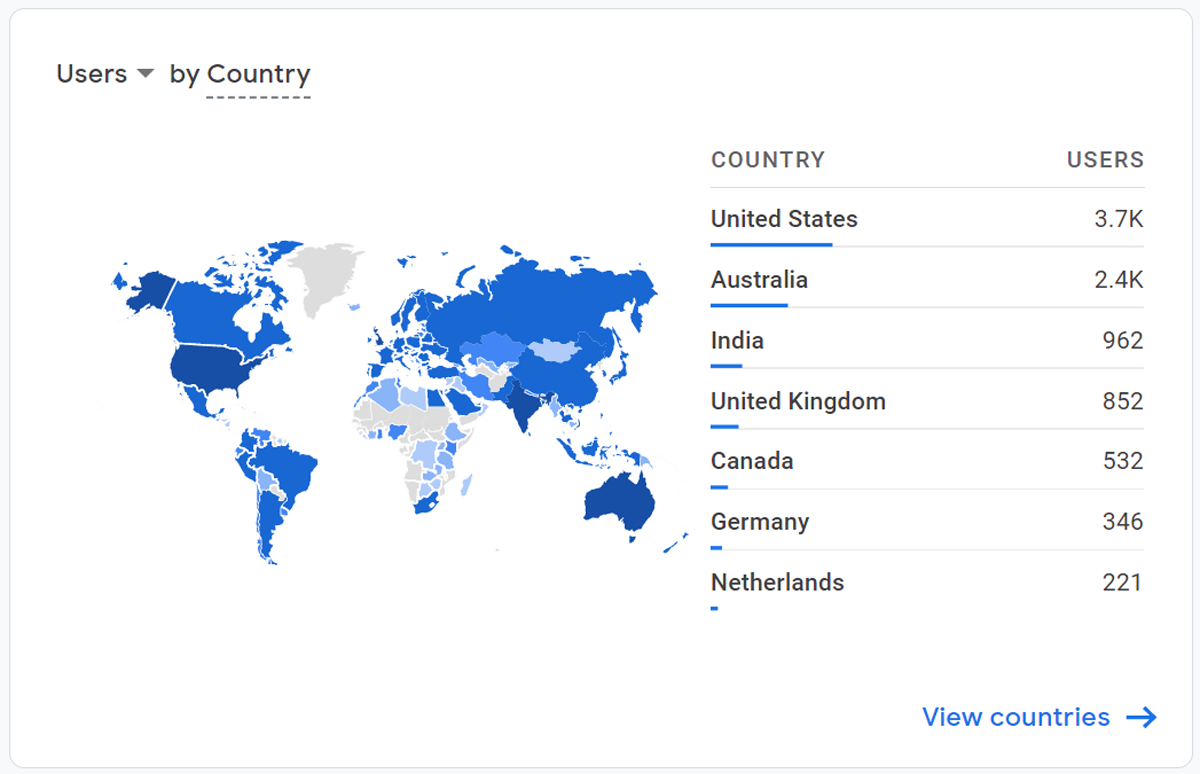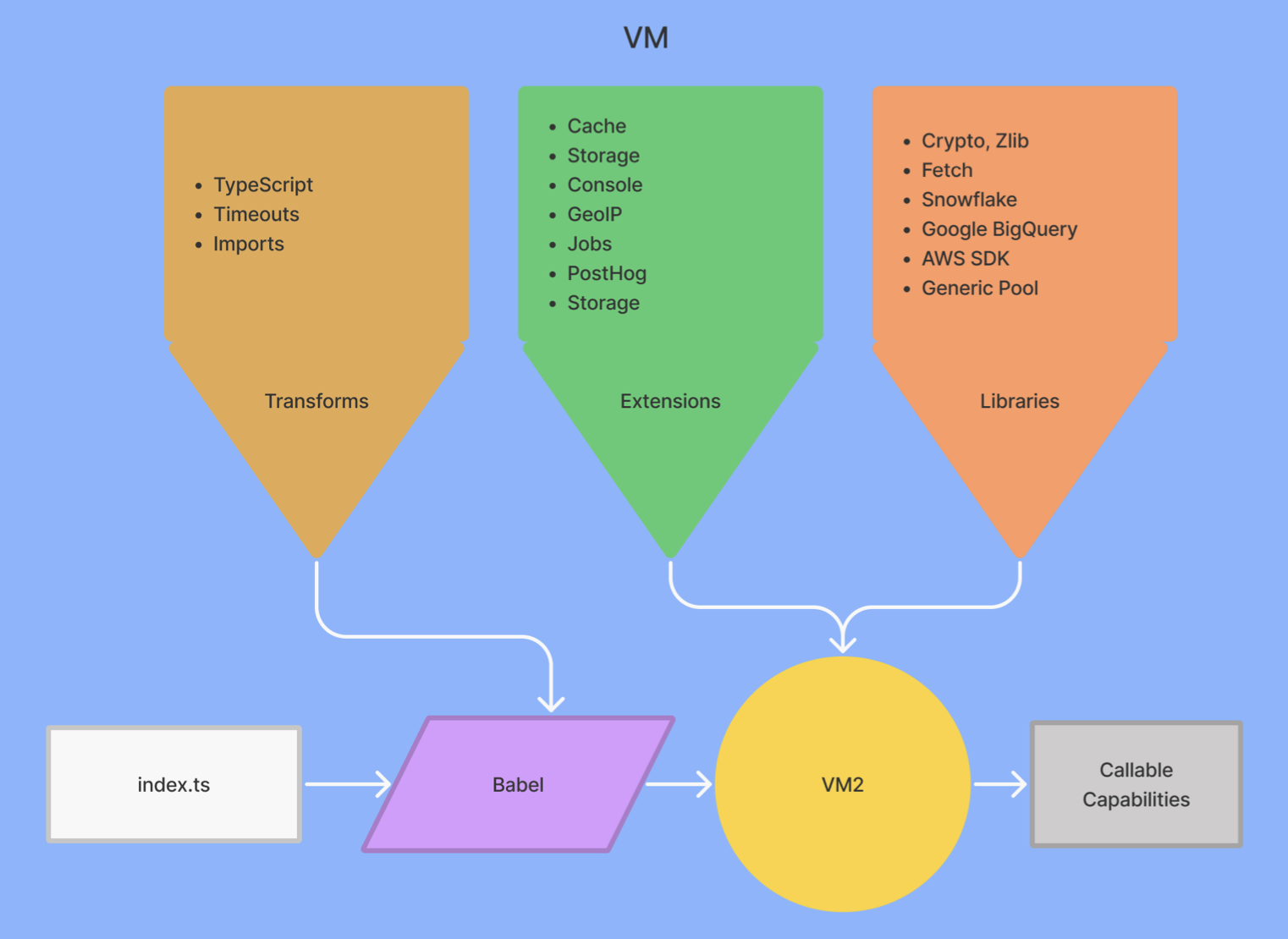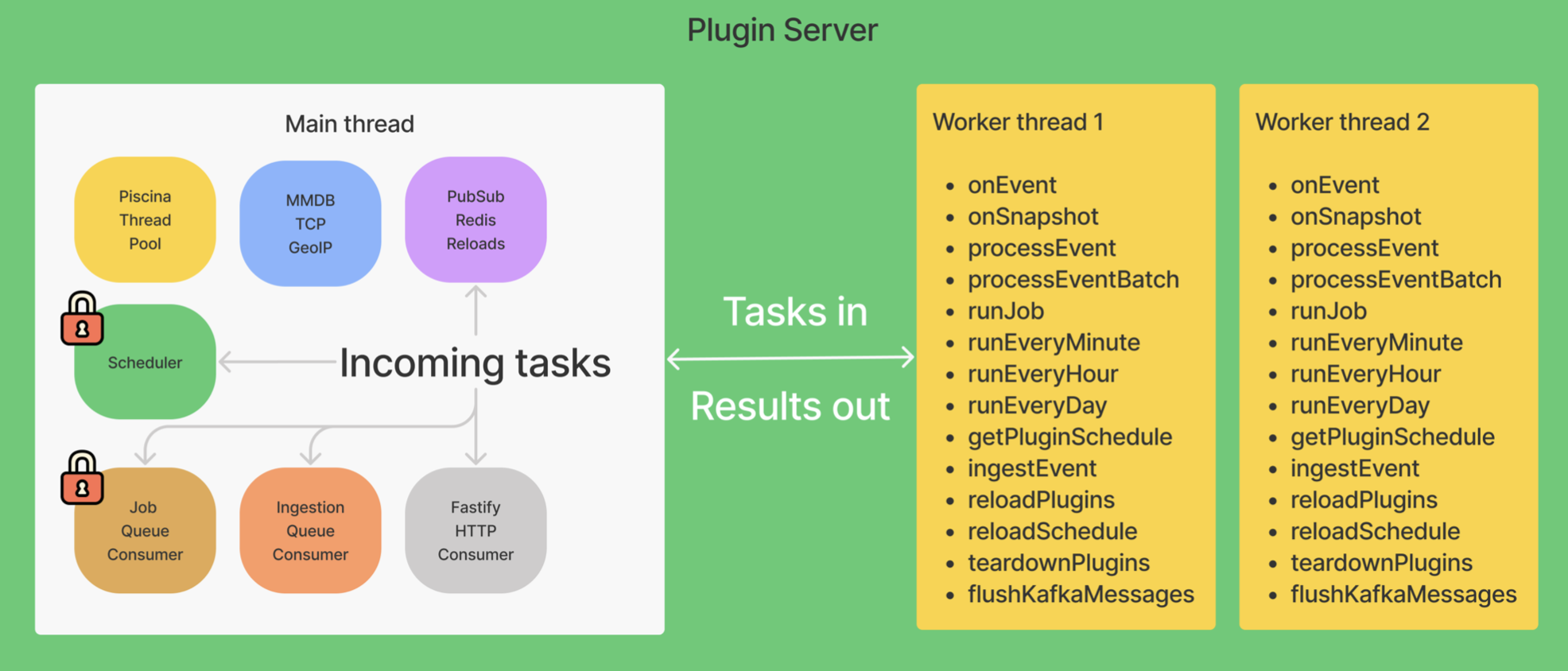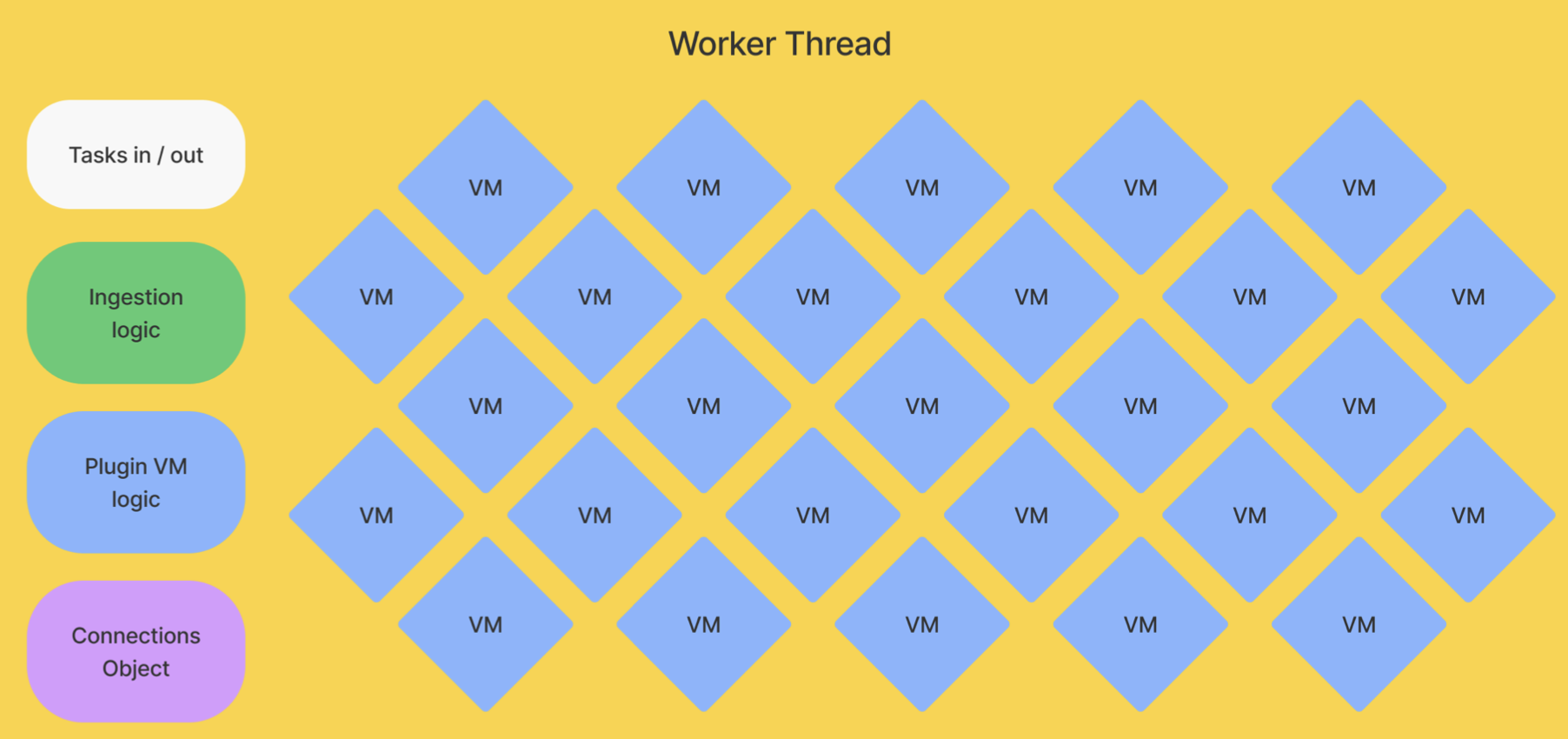We ingest and process billions of events to help companies build better products. We have many tools to help them do this such as customizable event capture, client and server libraries, data insights, and more. We are always trying to better fulfill the needs of our users, but we sometimes we can't build the customized solution they need.
At one point in our journey, we realized the ability to customize the processing of data was missing. Many users wanted to add geographic data to events, get events from CRMs, export data to BigQuery, and more. Use cases were endless, so we needed to give them the ability to do this themselves.
To do this, we built the ability to build and use apps integrated into our ingestion pipeline that run tasks, process and modify events, and connect to external services. Anyone can write and use apps to change their data flows, creating endless customization for their needs.
Like many features, it started as a hackathon MVP and developed into a service that now handles billions of events. Here are how we built it and the lessons we learned along the way.
Apps started as an MVP that came together in 3 days. Marius created it to scratch his itch for a world map that existed in Google Analytics but didn’t in PostHog. The map required location data from IP addresses. There were many services to do this, but connecting them to event data going was difficult.

The idea expanded to enable more modification of the events pipeline such as backing up data to S3, syncing GitHub stars, or getting customer feedback.
The three-day hackathon led to the ability to write and run arbitrary Python code. It got downloaded from GitHub, extracted, and integrated into PostHog. It specifically required Python 3.9, because Python 3.8’s zipimport didn’t support the zip archives GitHub provides.
An app at this point looked like this:
Other features added included a plugin repository, an interface to configure the apps, and a CLI to preconfigure apps for custom installations. Two sample plugins were built with it: the currency normalizer (convert event properties to a single currency), and the coveted GeoIP app.
It didn’t take long for cracks to appear. First, it’s nearly impossible to manage Python dependencies via multiple requirements.txt files. There's no way to tell which dependencies your plugin's dependencies will install, without first installing them. There is nothing like pip --dry-run. You need to install the pip package and run an __init__.py script inside the package to get its dependency tree.
What's more, all dependencies get installed together. This makes it just a matter of time before a plugin overrides an app dependency (e.g. django), and brings everything crashing down. This wasn’t going to work for us, so we needed to rebuild.
After deciding to rebuild, the first attempt was using PyMiniRacer to generate JavaScript. PyMiniRacer is great for simple functions, but lacked support for async/promises and importing modules like fetch because it was raw v8, not Node. It also had a limited standard library. All of which led to the decision it also wasn’t going to work.
Marius also tried to develop and subsequently scratched a gRPC implementation in Node. He was able to call JS code from Python and get a response, but this approach left us with a lot of manual work. It raised questions such as "how many workers should respond to the gRPC calls?" and "how do we make sure no events are lost if the node gRPC server is down?” Apps needed to scale, so this also wasn’t going to work.
In our main PostHog app, we use Celery to process events. When an event hits /capture, our API parses the request and queues the event into a job queue. Marius realized he could build a new server with the Node port of Celery and plug that in as another step in the existing pipeline.
This would solve all pending issues: we wouldn't have to worry about Python dependencies, we could potentially run untrusted code in a fast sandbox, there would be no process management for a gRPC link, and we could eventually rewrite the entire ingestion pipeline in Node to get a speed boost over Python.
Using celery required us to build a Node app that:
- Gets a stream of events from Python through a Redis queue (via celery.node)
- Runs user-defined JavaScript on that stream of events.
- Sends them back to Python through the same queue for ingestion.
The first and last steps were easy enough with our app structure and Celery, but we needed to make sure the arbitrary, user-defined JavaScript code was securely run.
The solution to the second step was to use VMs (Virtual Machines). Turns out Node. v14 has a built-in VM module that enables running custom JavaScript in a separate context.
Using the VM module enabled Javascript code to be “compiled and run immediately or compiled, saved, and run later.” The downside was that “the VM module is not a security mechanism. Do not use it to run untrusted code.” This wasn’t unexpected. Privilege escalation and resource exhaustion attacks are real. We couldn’t avoid them, but we could build strategies to mitigate them.
Node's VM module also puts your code in an isolated context, has limited no support for secure communications with the host, and has holes like this:
Thus we needed an abstraction. The two most popular are isolated-vm and vm2 :
isolated-vmis used by various big companies and claims to be secure. Each "isolate" runs in a new thread, with controllable CPU and memory limits. There are methods to copy data between the main thread and an isolate, and we can share objects and functions between the host and the isolate. It's not a perfect sandbox, but it's as close as we can get.vm2has a different isolation model. Each "VM" runs in an isolated NodeVM context, in the same thread as the rest of the app. There are no memory or CPU limits we can enforce. You run the code locally, but don’t share any variables with the host app.
While isolated-vm felt like a great fit because of its emphasis on security, its implementation wasn't a success.
At the end of the day, I (Marius) would have had to implement some proxying code similar to vm2, just to get fetch working, and decided it's not worth the effort, considering the time budget and the extremely likely case that I'll leave in some security holes.
vm2 didn't have this problem, as it had its own system of proxies that make sharing code between the host and the VM seamless.
Because of this, we decided to change our security model. On PostHog Cloud, we would vet the apps ourselves, before allowing everyone to use them. Self-hosted users were free to write and use as many arbitrary apps as they please.
This maintains self-hosted users’ freedom, while still enabling Cloud users to benefit from community apps. Apps are all developed and tested in the open. We just need to do a final manual check before installing them. After launch, we found many of our most used apps came from our community, proving this decision’s success.
- Python, which we wrote our ingestion pipeline in, wasn’t going to work. Dependency management was too difficult.
- Apps needed to scale while having access to some key JavaScript libraries. Using Node and Celery enabled us to integrate into our ingestion pipeline while providing the functionality we needed.
- We needed to make sure the code apps were running was secure and sandboxed. VMs were the answer to this, and Node had support for VMs.
- The default NodeVM wasn’t secure and couldn’t communicate with a host.
isolated-vmwas secured but needed proxying.vm2had the ability to proxy code, but was less secure.vm2and a review process for Cloud apps was the ultimate decision.
These learnings led to our current app structure.
After creating a basic MVP, and seeing the benefits of its usage, work continued on apps. They evolved and functionality grew over time. Where did they end up? Apps structure and features follow.
Each app contains two key files:
index.js(orindex.ts) which contains key application logic, modifies events, connects with external services, and interacts with PostHog. It has an allowlist of libraries to use for utilities or interacting with other services. It also has access (through the VM) to meta information, storage, and logging.plugin.jsoncontains configuration data for the app, what shows up in PostHog, and variables for end users to modify. The file contains the name, description, and other details that show up on the front end.
Here’s what a basic index.js looks like:
And here’s a basic plugin.json that goes along with it:
Within each index file, there are multiple functions and standard objects passed to those functions. These include setupPlugin, processEvent, onEvent, and scheduled functions. The event processing functions take an event, a config (meta) object (which contains configuration details), and VM-related extensions like storage, caching, and logging. Functions end return updated events, capture new events in PostHog, or send data to external services.
Specifically, our server exports predefined functions that run on conditions like:
- event ingestion (
processEvent)- useful for modifying incoming data, such as adding geographic data properties or dropping events matching a property filter.
- every minute, hour, day (
runEveryMinute,runEveryHour,runEveryDay)- useful for triggering events based on updates to external services such as Stripe, HubSpot, or GitHub
- once processing is complete (
exportEvents,onEvent)- useful for exporting data to external services such as BigQuery, Snowflake, or Databricks
We built each of these to fulfill use cases that help users keep control and get the most out of their data.
We export, transform, and connect these functions to extensions like storage, logging, and caching. This, ultimately, turns them into callable functions. Here’s a diagram of what a callable function VM looks like:

Once completed and uploaded, these apps are connected to PostHog through our app library or services like npm and GitHub. Once the app code is exported and transformed, it runs on the VMs (above) as part of our ingestion pipeline.
This structure and functionality make it simple to build an app while maintaining enough customizability for many use cases. We have continued to build functionality, like scheduling and services, into apps over time that help them better fulfill use cases for users.
Although using VMs solved many of our potential security, infrastructure, and usability issues, it didn’t solve all of them. Apps contain arbitrary code, and arbitrary code is dangerous. We’ve taken multiple steps to limit this.
First, there are limitless libraries for JavaScript, but we only allow a small portion of them. You can’t install and use whatever npm package you like. We include basic packages such as Node’s standard crypto, url, node-fetch, and zlib libraries. We also include libraries like snowflake-sdk, @google-cloud/bigquery, and pg to connect external services. This ensures that the code run by our users and servers uses libraries we trust.
Second, users can write a loop that loops forever and causes resource exhaustion. To prevent this, we set up a babel plugin that injects code into for, while, and do while loops (as described in this article). Whenever there is a loop, we set up a timer before we start it. If the loop runs for more than 30 seconds, the program errors.
Third, to prevent data loss, we added the ability to retry logic to our processEvent function. Kafka handles retries for us by batching events and adding failed ones into the dead letter queue. We added the ability to run functions on RetryError to improve consistency. App developers can also run fetches with retry. Here’s an example of what it looks like:
Fourth, we made it easier to write high-quality apps. The biggest things we did here were creating an app template and scaffold for users, including Jest to test the app, and the ability to write the app in TypeScript. Many more minor improvements added up to higher-quality apps getting written.
Finally, as mentioned before, although our self-hosted instances can run whatever arbitrary code they want, we still review apps before adding them for everyone to use on Cloud. This ensures a final quality and security standard for users.
The next step after creating an app (and making sure it doesn’t break things) is putting it into use. The plugin server serves and manages apps along with other processes in the ingestion pipeline. We needed to make sure apps integrate into the ingestion process, and not just bolt on. To show you how we did that, here’s a complete overview of what the plugin server looks like (our app server only utilizes some parts):

The main thread routes incoming tasks to the right location. It receives data and starts threads to complete them. We use Piscina (a node.js worker pool) to create and manage the threads. Piscina abstracts away a lot of the management of threads we would need to do to scale. The main thread also handles the functionality of scheduling and job queuing. The result is created tasks being sent to worker threads to complete.
Worker threads receive tasks from the main thread and execute them. Some of the tasks, like processEvent or runEveryMinute use the app code we detailed above. Worker threads contain the VMs, as well as the ingestion logic and connections to extensions and libraries. Each worker thread can run up to 10 tasks at the same time.

When the worker thread finishes its task, it returns to the main thread for further processing. This could include more modification through apps, PostHog person processing, or writing to ClickHouse. A final onEvent task runs once all the processing completes, which is useful for functions like exporting or alerting.
This structure enables modularity, and many different types of tasks, including app-related ones, can run together. Work improving the code for the plugin server improves all of the processes. This also lowers the maintenance needed for having multiple systems.
The final step is to make app functions and servers scale to the billions of events we process. Apps needed to integrate with our ingestion pipeline. Below is a basic diagram of our ingestion pipeline. Most of what we care about is the plugin server and the Kafka data flow leading into it.
Kafka manages our data flows. It helps us batch, split, and manage parallel work for our apps. For example, Kafka helps us batch and retry events when apps call processEvent. We use a Kafka topic (which holds messages and events in a logical order) to continue the flow of data.
Another service we use is Redis to cache data and back the queue for apps. Many parts of the app are reusable and don’t need to be rebuilt each time we run the app. There is data we only need to keep around temporarily. Using Redis to cache data like this dramatically improved app performance and lowered the number of app servers we needed to run.
We also use a couple of Redis patterns. First, we use Redlock for the scheduler and job queue consumer. Redlock ensures these processes are only run on one machine because we only want them to run once. If they ran more than once, we’d have duplication and issues. For example, we only need one scheduler to do the basic work of saying what to do at what time. Second, we use Pub/Sub to check for updates to the apps.
The app (plugin) server itself runs in Node. It runs all the processes detailed in the plugin server section above. Finally, events write to ClickHouse. We’ve detailed in the past why ClickHouse is uniquely suited for handling the billions of events we store there.
Because apps integrate into our ingestion pipeline, they benefit from all the work that goes into keeping the pipeline running smoothly and efficiently. Instead of thinking about apps as a bolt-on, they are a key part of the process.
We’ve seen users large and small write apps for all sorts of use cases. There are large companies writing apps to enhance events with critical data. There are also solo devs writing apps to scratch their own itch and end up used by thousands in our community. Apps unlocked more control over data flows as well as more innovation on the PostHog platform.
Building and scaling the app server fundamentally changed the way we think about our product and infrastructure. Work on apps helped our ingestion pipeline become more integrated and modular. Apps also made our product more customizable and open to permissionless innovation. As an example of this, see the release of site apps, which were inspired by apps and provide similar customizable functionality in the front end.
The ability to leverage PostHog to customize, control, and fully utilize your data will continue to improve. Apps, and many other features of PostHog, help with this. In the end, PostHog aims to help you understand your product and gives you the tools to build a better one.
- Feeling inspired? Learn how to make your own app.
- More of a front end person? Check out our tutorial on building site apps.
- Want to dive deeper into apps? Check out our app docs


